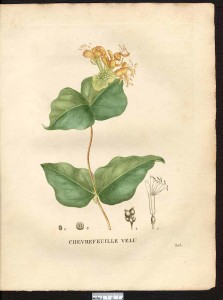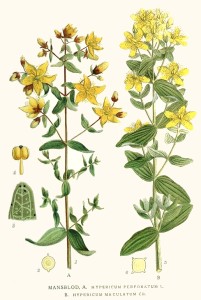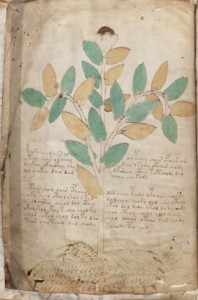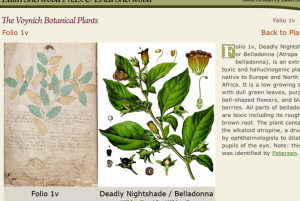This is a large plant occupying most of the page, with two text blocks broken across the lower stem.
The plant is distinctively painted red and green. The center stalk shows red on the right and green on the left. The side stalks somewhat alternate red and green. This could mean that red and green leaves are present on the plant or that one side of the leaf might be red, the other green (or contrasting colors that are symbolized by red and green, since the VM illustrator had a limited palette).
The leaves appear to be elliptical clasping, or possibly sagittate clasping (or at least positioned very close to the stem. The branching stems have been left uncolored, as has the calyx in which a rounded, dark brown shape, possibly a berry, nestles. The central stalk is shown erect (perhaps to show the flower head more clearly?) and the side stems curve gently.
The root is distinctive, very large, with a semi-even rough texture rendered over the whole surface, and claw-like side roots. In fact, the whole shape of the root resembles bear feet, except that there are three nodes rather than two.
Prior Identifications
Edith Sherwood has identified this as deadly nightshade (Atropa belladonna). It originally occurred to me that it might be some form of nightshade due to the berry-like shape at the end of the top stem and the vine-like curve to the left and right branches, especially since some species of nightshade can have large roots, but there are a number of ways in which nightshade differs from the Voynich plant, so I didn’t want to assume VM 1v was nightshade until I had looked at other possibilities.
One thing that stands out about the VM plant drawing is the way the leaves are attached—whereas nightshade leans toward having petioles, the VM leaves appear to be clasping (or nearly so). The VM plant alternates red and green but nightshade is usually a fairly consistent shade of green. Nightshade stems can sometimes be reddish. The VM “berry” is at the end of the stalk, whereas nightshade berries grow from the nodes, and the calyx of the VM plant is rounded, not pointed like Atropa belladonna. Perhaps the most significant difference between the VM plant and Atropa belladonna is that the leaves of nightshade are alternate, whereas the VM 1v leaves are predominantly opposite.
In other words, the VM plant only superficially resembles Atropa belladonna and there are many other plants that resemble it more closely. It might be an inexpertly drawn version of nightshade, but even an amateur illustrator can usually tell the difference between opposite and alternate leaves, so I’m putting nightshade off to the side, at least for now.
Disappointed at abandoning nightshade, a plant I rather like and which grows in my garden, I searched for other vines that have berries or cup-shaped flowers with a rounded calyx. I also kept in mind that VM 1v might not be a vine at all, but I’m inclined to think it is—not the kind that sends out tendrils and climbs like a pea but a plant that is semi-upright and tends to lean and curve as the branches get longer. I concentrated on plants with opposite leaves, even though there is an occasional leaf on VM 1v that isn’t perfectly opposite. While most plants tend to “choose” one or the other, not all plants hold slavishly to specific leaf patterns, some will have opposite leaves near the base and smaller alternate leaves near the ends of branches, for example.
The VM illustrator teases us by not making it clear whether the knob at the top is a flower or berry and by not indicating whether the plant has radiating or parallel veins (or perhaps it’s a clue that the veins are less obvious than on other plants). As with many of the drawings, there’s enough information to tantalize without making the identification truly obvious.
Alternate Identifications
 Lonicera, the familiar honeysuckle, has opposite leaves that are somewhat clasping and sometimes perfoliate. It is a somewhat stiff vine and some species have berries at the end of branches rather than at the nodes. The leaves do not alternate red and green but the stems are often reddish. Interesting also is that in several of the Lonicera species you have to look closely to see the radiating veins—the central vein is visible, but the smaller veinlets are not as contrasty or obvious as in other plants.
Lonicera, the familiar honeysuckle, has opposite leaves that are somewhat clasping and sometimes perfoliate. It is a somewhat stiff vine and some species have berries at the end of branches rather than at the nodes. The leaves do not alternate red and green but the stems are often reddish. Interesting also is that in several of the Lonicera species you have to look closely to see the radiating veins—the central vein is visible, but the smaller veinlets are not as contrasty or obvious as in other plants.
Where honeysuckle differs most significantly from VM 1v is that the berries tend to be numerous and they don’t have the distinct smooth-ended calyx of VM 1v. While Lonicera deserves some consideration and sometimes has very substantial roots, I’m don’t know if VM 1v is close enough to be honeysuckle.
Loosestrife (Lysimachia) also has opposite leaves and berry-like fruits at the end of the vine-like stalks. The stems are often red and the fruits have a calyx that wraps around the bottom of the “berry”. Where the plant differs most from VM 1v is that the calyx has pointed rather than round tips and the end of each “berry” has a fairly long and distinctive spike. Also, like Atropa, the fruits grow not only from the end of the branches but also from the nodes and there are frequently many fruits in a cluster.
Fringed Loosestrife (Lysimachia ciliata) tempts us by having red leaves near the base and fruits at the ends of the branches. There is a Troy University herbarium specimen that has a single flower at the end of a long stem. The plant can be quite variable and some varieties have red edges to the leaves, some have reddish leaves and some have leaves that border on clasping. It’s tempting to think VM 1v might be Lysimachia ciliata, or one of its close relatives, but most of the leaves are petioled and the roots have fine tendrils rather the thick bootlike stump of the VM 1v. I found one variety with a rather clumpy root but it didn’t resemble VM 1v in other ways—the flowers were numerous and extended from many of the leaf nodes.
 Perhaps the most intriguing possibility is a plant found in many parts of the world called St. John’s wort (Hypericum and Triadenum). St. John’s wort isn’t technically a vine, but it tends to lean as the branches grow and form round berry-like fruits in the fall. The fruits are often numerous but sometimes single. The leaves are opposite and sometimes appear to be clasping.
Perhaps the most intriguing possibility is a plant found in many parts of the world called St. John’s wort (Hypericum and Triadenum). St. John’s wort isn’t technically a vine, but it tends to lean as the branches grow and form round berry-like fruits in the fall. The fruits are often numerous but sometimes single. The leaves are opposite and sometimes appear to be clasping.
What is particularly interesting about Hypericum is that the leaves will sometimes alternate red and green, the stems are often red, and some species of St. John’s wort have leaves that are green on the topside and somewhat red on the underside. Oddly, very few botanical drawings record this aspect of the plant, most shows the leaves as medium-to-bright green, with little variation, and some neglect to show the ruddy color of the stems even in species where ruddy stems are frequent.
On many species of St. John’s wort, the fruit is a knob surrounded by bracts that are blunter than Solanum and other plants already mentioned. Sometimes these bracts are significantly rounded. Where the fruit differs from VM 1v is in having a little dark spike at the ends of the fruits (although not all Hypericum have this, some have a slight depression). Also, as the fruit ripens, the bracts tend to curve back away from the “berry” rather than wrapping around it.
The most perplexing difference between the St. John’s wort and Plant 1v is the roots. Hypericum roots can sometimes be quite woody and substantial, but nowhere near as thick and pawlike as those of VM 1v. Is the VM root indicative of a common name for this plant or a commentary on the fauna found in the plant’s habitat as is true of some medieval herbals, or is this an entirely different plant from those mentioned so far?
The ID is not definitive—these are only possibilities—yet despite the discrepancies from the VM plant, honeysuckle (with its burly roots) and St. John’s wort (with its leaf shapes, colors, and berry structures), should probably be kept in the queue.
Posted by J.K. Petersen


